How to show menu on Panasonic PT-RQ35K Projector?
- SSteven CarrollSep 12, 2025
If the menu screen does not appear on your Panasonic Projector, check if the on-screen display function is turned off (hidden).
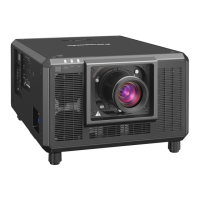
How to show menu on Panasonic PT-RQ35K Projector?
If the menu screen does not appear on your Panasonic Projector, check if the on-screen display function is turned off (hidden).
Why don't the buttons work on my Panasonic PT-RQ35K Projector?
If the buttons on the control panel of your Panasonic Projector do not operate, consider the following: * Check if the [CONTROL PANEL] setting in [CONTROL DEVICE SETUP] is set to [DISABLE]. * Verify if the terminal is used for contact control.
Why can't I adjust geometry on my Panasonic PT-RQ35K Projector?
If geometric adjustment is not possible on your Panasonic Projector, check if [QUAD PIXEL DRIVE] is set to [OFF].
Why can't I control my Panasonic PT-RQ35K Projector with Art-Net?
If you cannot control the Panasonic Projector with Art-Net, consider the following: * Verify that the connections between the twisted-pair-cable transmitter and an external device, and between the twisted-pair-cable transmitter and the projector are correctly done. * Ensure that [Art-Net SETUP] is set to other than [OFF]. * Check if [NET], [SUB NET], [UNIVERSE], and [START ADDRESS] are set correctly.
Why can't I switch to the Interface Board input on my Panasonic PT-RQ35K?
If you cannot switch to the input of the Interface Board on your Panasonic Projector, ensure that the Interface Board is correctly installed in the slot.
| Contrast Ratio | 20, 000:1 |
|---|---|
| Light Source | Laser |
| Projection System | 3-Chip DLP |
| Light Source Life | 20, 000 hours |
| Lens Shift | Vertical: ±60%, Horizontal: ±30% |
| Input Terminals | HDMI, DVI-D |
| Output Terminals | HDMI |
| Control Terminals | RS-232C, LAN, USB |
| Operating Temperature | 0°C to 45°C (32°F to 113°F) |
| Operating Humidity | 20–80 % (no condensation) |
| Brightness | 30, 000 center lumens |
Essential safety guidelines, handling, installation, and operational cautions for projector use.
Details the projector body, control panel, and remote control unit layout and functions.
Describes various input/output terminals for connecting devices, interface boards, and control signals.
Covers battery insertion, usage with multiple projectors, and wired connection options.
Explains usable outlets, installation modes (desk, ceiling, front, rear), and angle sensor usage.
Provides information on projected image size, throw distance, and lens compatibility for installation.
Details how to connect external devices like AV equipment and computers via various terminals.
Illustrates network connections using twisted-pair-cable transmitters for video, Ethernet, and serial control.
Covers connecting the power cord, using the main power switch, and projector power indicators.
Describes starting projection, selecting input signals, and adjusting image parameters like focus and zoom.
Explains how to switch between different input sources using the remote control or control panel.
Details procedures for adjusting focus, zoom, and lens shift using the control panel or remote control.
Explains how to access and navigate through the projector's on-screen menu system for settings.
Covers adjustments for picture mode, contrast, brightness, color, tint, and color temperature for optimal image.
Allows adjustment of image position (shift), aspect ratio, zoom, geometry, and convergence.
Includes settings for digital cinema reality, gradation smoother, blanking, edge blending, and frame response.
Manages color matching, screen settings, auto signal setup, input settings, and display language.
Covers projector ID, projection method, lens settings, operation modes, brightness control, and network settings.
Provides built-in test patterns to check projector condition and aid in adjustments like focus.
Allows registering, renaming, and deleting input signals for custom configurations.
Manages password settings for the projector and control devices, and enables/disables button operations.
Configures Ethernet type, DIGITAL LINK, wired/wireless LAN settings, and administrator accounts.
Details connecting via wired LAN, wireless LAN, and using the QR code for smartphone connection.
Explains how to access and control the projector settings, status, and send email alerts via a web browser.
Describes how to check projector status, input information, network status, and firmware versions via the information monitor.
Covers copying projector settings via LAN or USB memory to multiple projectors.
Explains how to update the projector firmware via LAN or USB memory.
Explains the meaning of indicator lights (red, blinking) for light source and temperature warnings and their solutions.
Provides instructions for cleaning the outer case and the projection lens surface.
A guide to common issues like no power, no image, fuzzy image, or remote control problems with solutions.
Lists alphanumeric symbols for errors/warnings and their corresponding actions and details.
Covers PJLink commands, Art-Net functions, control commands via LAN, and serial communication details.
Details physical dimensions, display specs, light source, contrast, compatibility, and interface information.
Provides instructions for installing and removing optional interface boards like HDMI, DVI-D, and SDI.
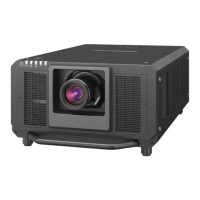
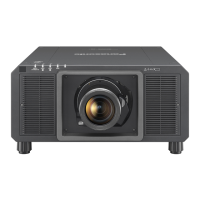
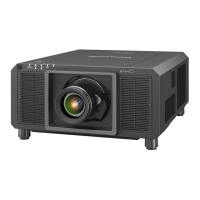
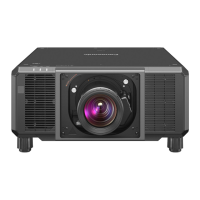
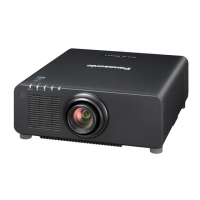
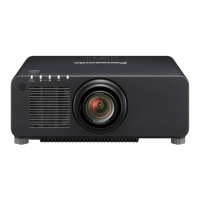
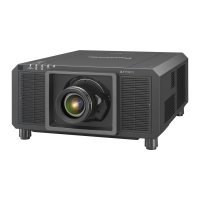
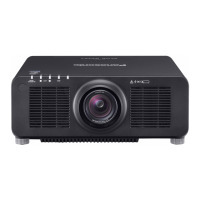

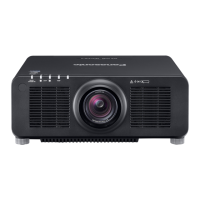
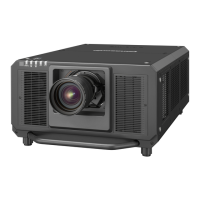
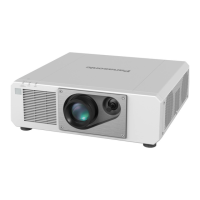
